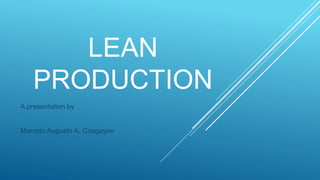
0201B Lean Production
- 1. LEAN PRODUCTION A presentation by Marcelo Augusto A. Cosgayon
- 2. DEFINITION Lean manufacturing or lean production, often simply "lean", is a systematic method for the elimination of waste ("Muda") within a manufacturing system. Lean also takes into account waste created through overburden ("Muri") and waste created through unevenness in work loads ("Mura").
- 3. WASTE (MUDA) Anything other than the minimum amount of equipment, materials, parts, space, and time that are absolutely essential to add value to the product.
- 4. KINDS OF WASTE (TIMWOOD) 1. Transporting 2. Inventory 3. Movement 4. Waiting 5. Overproduction 6. Over Processing 7. Defects
- 5. TRANSPORTING Moving products that are not actually required to perform the processing
- 6. INVENTORY all components, work in process, and finished products not being processed
- 7. MOVEMENT people or equipment moving or walking more than is required to perform the processing
- 8. WAITING waiting for the next production step, interruptions of production during shift change
- 10. OVER PROCESSING resulting from poor tool or product design creating activity
- 11. DEFECT the effort involved in inspecting for and fixing defects
- 12. ELEMENTS 1. Flexible resources 2. Cellular layouts 3. Pull system 4. Kanbans 5. Small lots 6. Quick setups 7. Uniform production levels 8. Quality at the source 9. Total productive maintenance 10.Supplier networks
- 14. FLEXIBLE RESOURCES •Multifunctional Workers – instead of specialized workers performing a single task, workers are trained to be able to perform multiple tasks •General Purpose Machines – machines capable of performing several basic functions •Takt Time – from the German word for “baton”, this refers to the pace at which production should take place to match the rate of customer demand ELEMENTS
- 15. CELLULAR LAYOUTS Manufacturing Cells – dissimilar machines grouped together to manufacture a family of parts with similar shapes or processing requirements, resembling a small assembly line. These use smaller multipurpose machines operated by a single worker to produce several parts before passing them on to another cell. Because cells produce similar items, setup time requirements are low and lot sizes can be reduced. Movement of output from the cells to subassembly or assembly lines occurs in small lots and is controlled by kanbans ELEMENTS
- 16. PULL SYSTEM Pull System – relies on demand instead of supply to provide a continuous flow of materials and parts in the production process. This eliminates the need for high inventory of materials and parts to avoid stockouts and a stoppage of work. It also prevents overproduction and underproduction because workers only produce what is needed and no more and no less. ELEMENTS
- 17. ELEMENTS Kanban - a card that corresponds to a standard quantity of production. These cards contain basic information such as part number, brief description, type of container, unit load (i.e., quantity per container), preceding station (where it came from), and subsequent station (where it goes to). Kanbans are essential for the push system to work by determining when work should be done KANBANS
- 18. SMALL LOTS Products are manufactured in small lots at a time. This improves quality and reduces lead time because processes can be physically moved closer together and transportation between stations can be simplified. Quality problems can also be easily detected. These allow for remedial measures to be undertaken more quickly ELEMENTS
- 19. QUICK SETUPS Setup times can be reduced by: 1. Separate internal setup from external setup 2. Convert internal setup to external setup 3. Streamline all aspects of setup 4. Perform setup activities in parallel or eliminate them entirely ELEMENTS
- 20. UNIFORM PRODUCTION LEVELS Lean production systems require a uniform production level in order to maintain the flow of production created by the pull system, kanbans, small lots, and quick setups. This is done by smoothing the production requirements on the final assembly line by making accurate forecasts of demand. ELEMENTS
- 21. QUALITY AT THE SOURCE Extremely high quality parts are essential for lean systems to work. There is no extra inventory to act as a buffer against defective units and producing poor quality items that need to be reworked or rejected later on is a waste that must be eliminated ELEMENTS
- 22. TOTAL PRODUCTIVE MAINTENANCE Periodic preventive maintenance is required to prevent breakdown of machines that will cause work stoppages and an interruption in the production process. Total Productive Maintenance combines the practice of preventive maintenance with the concepts of total quality: employee involvement, decisions based on data, zero defects, and a strategic focus ELEMENTS
- 23. SUPPLIER NETWORKS Reliability of suppliers and the synchronization of their production to the needs of the customer are essential to the success of lean production. This can be done by ELEMENTS 1. Long-term supplier contracts 2. Synchronized production 3. Supplier certification 4. Mixed loads and frequent deliveries 5. Precise delivery schedules 6. Standardized, sequenced delivery 7. Locating in close proximity to the customer
- 24. BENEFITS 1. Reduced inventory 2. Improved quality 3. Lower costs 4. Reduced space requirements 5. Shorter lead time 6. Increased productivity 7. Greater flexibility 8. Better relations with suppliers 9. Simplified scheduling and control activities 10. Increased capacity 11. Better use of human resources 12. More product variety
- 25. DRAWBACKS 1. Requires steady demand to maintain production flow 2. Requires discipline 3. Not applicable to production of high volume repetitive items 4. Vulnerable to unexpected changes in demand or supply
